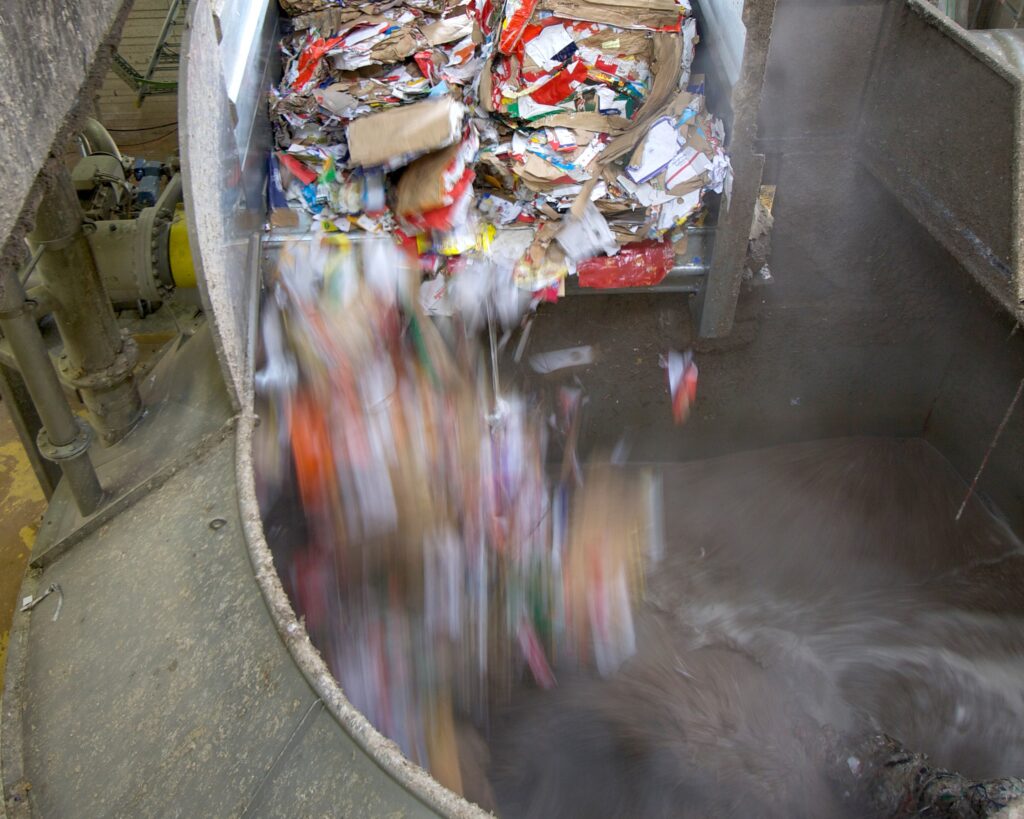Waste paper in, new pulp out – welcome to stock preparation
A look behind the scenes – or rather into the huge mixer and sorting facilities of paper production – shows that sophisticated recycling processes and state-of-the-art technology are needed to process around 2,000 tons of waste paper into new pulp every day.
Large bales of waste paper, consisting of pressed mixed paper, packaging and cardboard, are transported via conveyor belts to the paper production stock preparation area. There they are dissolved in water in pulpers, which are huge agitated vats.
Sorting out first
Before the material can be processed, some of it has to be sorted out. “Unfortunately, the large bales don’t just contain waste paper,” explains Hartmut Langner, line technologist in the paper production stock preparation department. From carpets and household appliances to shampoo bottles and car batteries – there are all kinds of surprises in the pressed waste paper that end up there accidentally or due to incorrect disposal. “We would like to see more education about what really belongs in waste paper. Careful separation of recyclable materials supports sustainable waste paper processing,” adds Jonas Hain, Head of Paper Production.

The waste paper is sorted in several steps to remove plastics, metal parts, foils or strings. This cleaning is crucial for the quality of the subsequent pulp from which new paper is produced. In addition to the large foreign objects, there are many smaller foreign materials, such as metal bars from folders or Tetra Paks. “Empty drinks packaging is often found in waste paper,” says Hain, “but it doesn’t break down well because of its plastic coating.” In technical terms, such impurities are called rejects. “In the paper division, we process around 2,000 tons of waste paper every day, which contains an average of 100 tons of rejects,” reports Langner. “With our modern reject processing plant, we also try to make these materials usable.”
Into the mixer
The waste paper is already mixed with water in the large pulpers during the sorting process. “You can think of it like a giant blender that turns the waste paper into pulp in 2 to 3 minutes,” says Langner. “However, our mixer has 1,100 HP, as if we were using 1,700 mixers at the same time.”
The pieces of paper are broken down into their fibers again and a fiber-water mixture, known as pulp, is created. The pulp undergoes further cleaning steps: screens and sorting units remove finer impurities such as sand or staples. The last adhesive residues and even the smallest paint chips, for example from glossy magazines, are removed in a special cleaning process. Stock preparation at PKV is a highly developed recycling process. The resulting light-colored pulp is the basis for new paper.
Where have all the good fibers gone?
Production is also noticing that the raw material situation is changing fundamentally, that less graphic paper is contained in the waste paper of the household mixed goods. “Instead, there is more and more packaging and specially coated cardboard packaging for food, which presents us with challenges when it comes to recovering the primary fibers,” Hain points out. “In future, other ways must be found to obtain sufficient primary fibers. There are already promising research projects on this.”
Paper production never sleeps
In stock preparation, 50 employees work in an interlocking five-shift system. Many of the employees have trained as paper technologists, but lateral entry from other technical training and study areas is also possible.
PKV’s two paper machines run 24 hours a day, seven days a week. “However, we have planned shutdowns every month,” explains Langner. “During this preventive maintenance, all machines are checked to ensure that there are no problems during operation.”
With a closed raw material cycle, innovative technology and consistent conservation of resources, PKV sets standards in the paper processing industry – efficient, environmentally friendly and forward-looking.